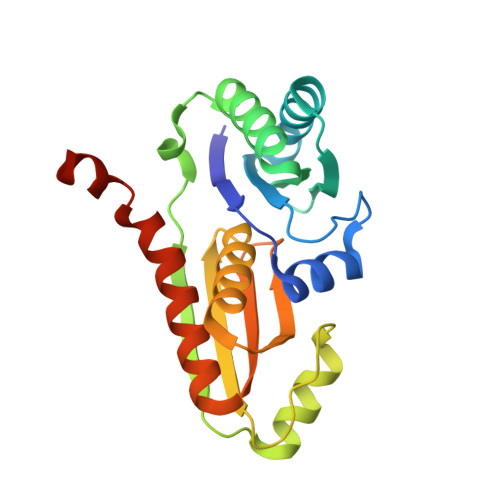A Complete Structural Inventory of the Mycobacterial Microcompartment Shell Proteins Constrains Models of Global Architecture and Transport.
Mallette, E., Kimber, M.S.(2017) J Biol Chem 292: 1197-1210
- PubMed: 27927988
- DOI: https://doi.org/10.1074/jbc.M116.754093
- Primary Citation of Related Structures:
5L37, 5L38, 5L39, 5SUH - PubMed Abstract:
Bacterial microcompartments are bacterial analogs of eukaryotic organelles in that they spatially segregate aspects of cellular metabolism, but they do so by building not a lipid membrane but a thin polyhedral protein shell. Although multiple shell protein structures are known for several microcompartment types, additional uncharacterized components complicate systematic investigations of shell architecture. We report here the structures of all four proteins proposed to form the shell of an uncharacterized microcompartment designated the Rhodococcus and Mycobacterium microcompartment (RMM), which, along with crystal interactions and docking studies, suggests possible models for the particle's vertex and edge organization. MSM0272 is a typical hexameric β-sandwich shell protein thought to form the bulk of the facet. MSM0273 is a pentameric β-barrel shell protein that likely plugs the vertex of the particle. MSM0271 is an unusual double-ringed bacterial microcompartment shell protein whose rings are organized in an offset position relative to all known related proteins. MSM0275 is related to MSM0271 but self-organizes as linear strips that may line the facet edge; here, the presence of a novel extendable loop may help ameliorate poor packing geometry of the rigid main particle at the angled edges. In contrast to previously characterized homologs, both of these proteins show closed pores at both ends. This suggests a model where key interactions at the vertex and edges are mediated at the inner layer of the shell by MSM0271 (encircling MSM0273) and MSM0275, and the facet is built from MSM0272 hexamers tiling in the outer layer of the shell.
Organizational Affiliation:
From the Department of Molecular and Cellular Biology, University of Guelph, Guelph, Ontario N1G 2W1, Canada.















